Deposition of Multilayer Nanostructured Coating Cr/(Cr/a-C)ml on Alloy Steels
Abstract
1. Introduction
2. Materials and Methods
3. Results
4. Discussion
5. Conclusions
Author Contributions
Funding
Data Availability Statement
Acknowledgments
Conflicts of Interest
Abbreviations
| PVD | Physical vapor deposition |
| CVD | Chemical vapor deposition |
| (Cr/a-C)ml | Chromium/amorphous carbon multilayer |
| DLC | Diamond-like carbon |
| EDS | Energy dispersive spectroscopy |
| SEM | Scanning electron microscope |
| MF | Medium frequency |
References
- Hovsepian, P.; Kok, Y.; Ehiasarian, A.; Erdemir, A.; Wen, J.-G.; Petrov, I. Structure and tribological behaviour of nanoscale multilayer C/Cr coatings deposited by the combined steered cathodic arc/unbalanced magnetron sputtering technique. Thin Solid Films 2004, 447–448, 7–13. [Google Scholar] [CrossRef]
- Al Mahmud, K.A.H.; Kalam, M.A.; Masjuki, H.H.; Mobarak, H.M.; Zulkifli, N.M. An updated overview of diamond-like carbon coating in tribology. Crit. Rev. Solid State Mater. Sci. 2014, 40, 90–118. [Google Scholar] [CrossRef]
- Liu, S.; Zhuang, W.; Ding, J.; Liu, Y.; Yu, W.; Yang, Y.; Liu, X.; Yuan, J.; Zheng, J. Fabrication and Tribological Properties of Diamond-like Carbon Film with Cr Doping by High-Power Impulse Magnetron Sputtering. Coatings 2024, 14, 916. [Google Scholar] [CrossRef]
- Gao, Z.; Buchinger, J.; Hahn, R.; Chen, Z.; Zhang, Z.; Koutná, N.; Mayrhofer, P. Bilayer period and ratio dependent structure and mechanical properties of TiN/MoN superlattices. Acta Mater. 2024, 279, 120313. [Google Scholar] [CrossRef]
- Bertran, E.; Corbella, C.; Pinyol, A.; Vives, M.; Andújar, J. Comparative study of metal/amorphous-carbon multilayer structures produced by magnetron sputtering. Diam. Relat. Mater. 2003, 12, 1008–1012. [Google Scholar] [CrossRef]
- Stueber, M.; Holleck, H.; Leiste, H.; Seemann, K.; Ulrich, S.; Ziebert, C. Concepts for the design of advanced nanoscale PVD multilayer protective thin films. J. Alloys Compd. 2009, 483, 321–333. [Google Scholar] [CrossRef]
- Mao, H.; Shen, F.; Zhang, Y.; Wang, J.; Cui, K.; Wang, H.; Lv, T.; Fu, T.; Tan, T. Microstructure and Mechanical Properties of Carbide Reinforced TiC-Based Ultra-High Temperature Ceramics: A Review. Coatings 2021, 11, 1444. [Google Scholar] [CrossRef]
- Mao, H.; Zhang, Y.; Wang, J.; Cui, K.; Liu, H.; Yang, J. Microstructure, Mechanical Properties, and Reinforcement Mechanism of Second-Phase Reinforced TiC-Based Composites: A Review. Coatings 2022, 12, 801. [Google Scholar] [CrossRef]
- Ratayski, U.; Schimpf, C.; Schucknecht, T.; Mühle, U.; Baertz, C.; Leonhardt, M.; Scheibe, H.-J.; Rafaja, D. On the Thermal Stability of Nanoscaled Cr/ta-C Multilayers; SAXONIA Standortentwicklungs- und –verwaltungsgesellschaft mbH: Freiberg, Germany, 2015; pp. 184–199. [Google Scholar]
- Hahn, R.; Bartosik, M.; Soler, R.; Kirchlechner, C.; Dehm, G.; Mayrhofer, P. Superlattice effect for enhanced fracture toughness of hard coatings. Scr. Mater. 2016, 124, 67–70. [Google Scholar] [CrossRef]
- Ul-Hamid, A. Microstructure, properties and applications of Zr-carbide, Zr-nitride and Zr-carbonitride coatings: A review. Mater. Adv. 2020, 1, 1012–1037. [Google Scholar] [CrossRef]
- Ul-Hamid, A. The effect of deposition conditions on the properties of Zr-carbide, Zr-nitride and Zr-carbonitride coatings—A review. Mater. Adv. 2020, 1, 988–1011. [Google Scholar] [CrossRef]
- Tao, H.; Zhylinski, V.; Vereschaka, A.; Chayeuski, V.; Yuanming, H.; Milovich, F.; Sotova, C.; Seleznev, A.; Salychits, O. Comparison of the Mechanical Properties and Corrosion Resistance of the Cr-CrN, Ti-TiN, Zr-ZrN, and Mo-MoN Coatings. Coatings 2023, 13, 750. [Google Scholar] [CrossRef]
- Koutná, N.; Brenner, A.; Holec, D.; Mayrhofer, P.H. High-throughput first-principles search for ceramic superlattices with improved ductility and fracture resistance. Acta Mater. 2021, 206, 116615. [Google Scholar] [CrossRef]
- Bai, H.; Li, J.; Gao, J.; Ni, J.; Bai, Y.; Jian, J.; Zhao, L.; Bai, B.; Cai, Z.; He, J.; et al. Comparison of CrN Coatings Prepared Using High-Power Impulse Magnetron Sputtering and Direct Current Magnetron Sputtering. Materials 2023, 16, 6303. [Google Scholar] [CrossRef] [PubMed]
- Cunha, L.; Andritschky, M.; Pischow, K.; Wang, Z. Microstructure of CrN coatings produced by PVD techniques. Thin Solid Films 1999, 355–356, 465–471. [Google Scholar] [CrossRef]
- Erdemir, A.; Martin, J.M. Superior wear resistance of diamond and DLC coatings. Curr. Opin. Solid State Mater. Sci. 2018, 22, 243–254. [Google Scholar] [CrossRef]
- Dalibón, E.; Escalada, L.; Simison, S.; Forsich, C.; Heim, D.; Brühl, S. Mechanical and corrosion behavior of thick and soft DLC coatings. Surf. Coat. Technol. 2017, 312, 101–109. [Google Scholar] [CrossRef]
- Ronkainen, H.; Varjus, S.; Holmberg, K. Tribological performance of different DLC coatings in water-lubricated conditions. Wear 2001, 249, 267–271. [Google Scholar] [CrossRef]
- Sedlaček, M.; Podgornik, B.; Vižintin, J. Tribological properties of DLC coatings and comparison with test results: Development of a database. Mater. Charact. 2008, 59, 151–161. [Google Scholar] [CrossRef]
- Salvadori, M.; Martins, D.; Cattani, M. DLC coating roughness as a function of film thickness. Surf. Coat. Technol. 2006, 200, 5119–5122. [Google Scholar] [CrossRef]
- Manninen, N.; Ribeiro, F.; Escudeiro, A.; Polcar, T.; Carvalho, S.; Cavaleiro, A. Influence of Ag content on mechanical and tribological behavior of DLC coatings. Surf. Coat. Technol. 2013, 232, 440–446. [Google Scholar] [CrossRef]
- Azzi, M.; Amirault, P.; Paquette, M.; Klemberg-Sapieha, J.; Martinu, L. Corrosion performance and mechanical stability of 316L/DLC coating system: Role of interlayers. Surf. Coat. Technol. 2010, 204, 3986–3994. [Google Scholar] [CrossRef]
- Zia, A.W.; Anestopoulos, I.; Panayiotidis, M.I.; Birkett, M. Soft diamond-like carbon coatings with superior biocompatibility for medical applications. Ceram. Int. 2023, 49, 17203–17211. [Google Scholar] [CrossRef]
- Kaneko, M.; Hiratsuka, M.; Alanazi, A.; Nakamori, H.; Namiki, K.; Hirakuri, K. Surface Reformation of Medical Devices with DLC Coating. Materials 2021, 14, 376. [Google Scholar] [CrossRef]
- Malisz, K.; Świeczko-Żurek, B.; Sionkowska, A. Preparation and Characterization of Diamond-like Carbon Coatings for Biomedical Applications—A Review. Materials 2023, 16, 3420. [Google Scholar] [CrossRef]
- Schalk, N.; Tkadletz, M.; Mitterer, C. Hard coatings for cutting applications: Physical vs. chemical vapor deposition and future challenges for the coatings community. Surf. Coatings Technol. 2022, 429, 127949. [Google Scholar] [CrossRef]
- Ginting, A.; Skein, R.; Cuaca, D.; Herdianto; Pieter; Masyithah, Z. The characteristics of CVD- and PVD-coated carbide tools in hard turning of AISI 4340. Measurement 2018, 129, 548–557. [Google Scholar] [CrossRef]
- Deng, Y.; Chen, W.; Li, B.; Wang, C.; Kuang, T.; Li, Y. Physical vapor deposition technology for coated cutting tools: A review. Ceram. Int. 2020, 46, 18373–18390. [Google Scholar] [CrossRef]
- Kamiya, S.; Nagasawa, H.; Yamanobe, K.; Saka, M. A comparative study of the mechanical strength of chemical vapor-deposited diamond and physical vapor-deposited hard coatings. Thin Solid Films 2005, 473, 123–131. [Google Scholar] [CrossRef]
- Li, X.; Dai, W.; Wang, Q.; Liang, Y.; Wu, Z. Diamond-like/graphite-like carbon composite films deposited by high-power impulse magnetron sputtering. Diam. Relat. Mater. 2020, 106, 107818. [Google Scholar] [CrossRef]
- Wang, M.; Liu, Y.; Chen, H.; Wang, L.; Hu, D. First-Principles Calculations of Interfacial Structure and Properties between WC Substrate and TiN Coating Based on Density Functional Theory. Coatings 2022, 12, 1076. [Google Scholar] [CrossRef]
- Yaqoob, S.; Ghani, J.A.; Jouini, N.; Juri, A.Z. Performance Evaluation of PVD and CVD Multilayer-Coated Tools in Machining High-Strength Steel. Coatings 2024, 14, 865. [Google Scholar] [CrossRef]
- Kucharska, B.; Czarniak, P.; Kulikowski, K.; Krawczyńska, A.; Rożniatowski, K.; Kubacki, J.; Szymanowski, K.; Panjan, P.; Sobiecki, J.R. Comparison Study of PVD Coatings: TiN/AlTiN, TiN and TiAlSiN Used in Wood Machining. Materials 2022, 15, 7159. [Google Scholar] [CrossRef]
- Tien, C.-L. Special Issue “Advanced Coating Technology by Physical Vapor Deposition and Applications”. Coatings 2023, 13, 467. [Google Scholar] [CrossRef]
- Krella, A. Resistance of PVD Coatings to Erosive and Wear Processes: A Review. Coatings 2020, 10, 921. [Google Scholar] [CrossRef]
- Deng, J.; Wu, F.; Lian, Y.; Xing, Y.; Li, S. Erosion wear of CrN, TiN, CrAlN, and TiAlN PVD nitride coatings. Int. J. Refract. Met. Hard Mater. 2012, 35, 10–16. [Google Scholar] [CrossRef]
- Zlamal, T.; Mrkvica, I.; Szotkowski, T.; Malotova, S. The Influence of Surface Treatment of PVD Coating on Its Quality and Wear Resistant. Coatings 2019, 9, 439. [Google Scholar] [CrossRef]
- D’Avico, L.; Beltrami, R.; Lecis, N.; Trasatti, S.P. Corrosion Behavior and Surface Properties of PVD Coatings for Mold Technology Applications. Coatings 2018, 9, 7. [Google Scholar] [CrossRef]
- Dabees, S.; Mirzaei, S.; Kaspar, P.; Holcman, V.; Sobola, D. Characterization and Evaluation of Engineered Coating Techniques for Different Cutting Tools—Review. Materials 2022, 15, 5633. [Google Scholar] [CrossRef]
- Fox-Rabinovich, G.; Gershman, I.S.; Yamamoto, K.; Dosbaeva, J.; Veldhuis, S. Effect of the Adaptive Response on the Wear Behavior of PVD and CVD Coated Cutting Tools during Machining with Built Up Edge Formation. Nanomaterials 2020, 10, 2489. [Google Scholar] [CrossRef]
- Džupon, M.; Kaščák, Ľ.; Spišák, E.; Kubík, R.; Majerníková, J. Wear of Shaped Surfaces of PVD Coated Dies for Clinching. Metals 2017, 7, 515. [Google Scholar] [CrossRef]
- BDS EN ISO 683-2:2018; Heat-Treatable Steels, Alloy Steels and Free-Cutting Steels—Part 2: Alloy Steels for Quenching and Tempering. European Standard: Brussels, Belgium, 2018.
- BDS EN ISO 683-17:2024; Heat-Treated Steels, Alloy Steels and Free-Cutting Steels—Part 17: Ball and Roller Bearing Steels. European Standard: Brussels, Belgium, 2024.
- BDS EN ISO 4957:2018; Tool Steels. European Standard: Brussels, Belgium, 2018.
- Gorman, D.; Green, C.; Fry, T.; Gee, M. Rockwell Indentation Test for Evaluation of Adhesion of Coatings—Aka Daimler-Benz Adhesion Test; National Physics Laboratory Report. MAT 107; NPL Management: London, UK, 2022. [Google Scholar] [CrossRef]
- ISO 26423:2009; Fine Ceramics (Advanced CERAMICS, advanced Technical Ceramics)—Determination of Coating Thickness by Crater-Grinding Method. International Standard: Geneva, Switzerland, 2009.
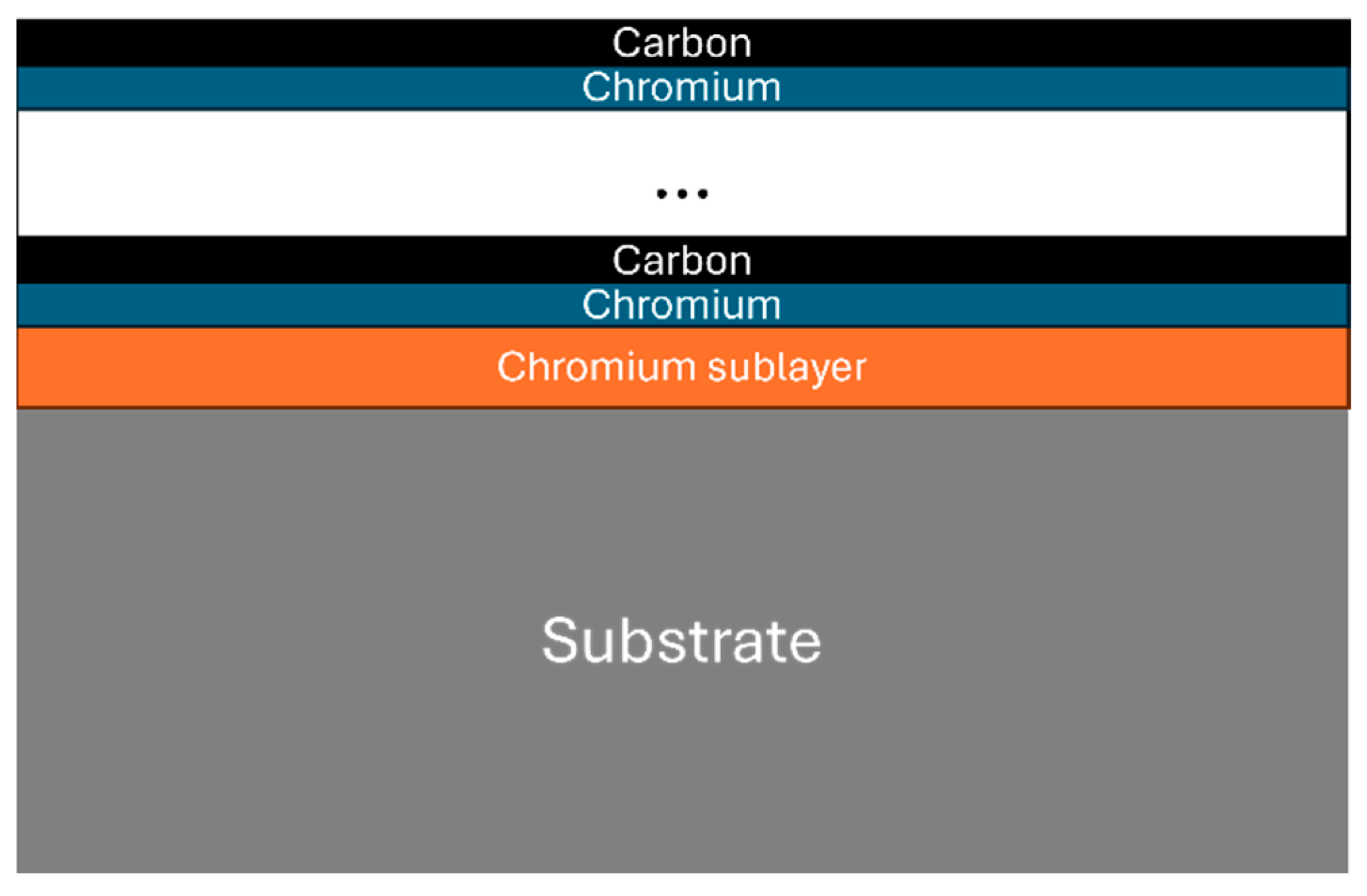
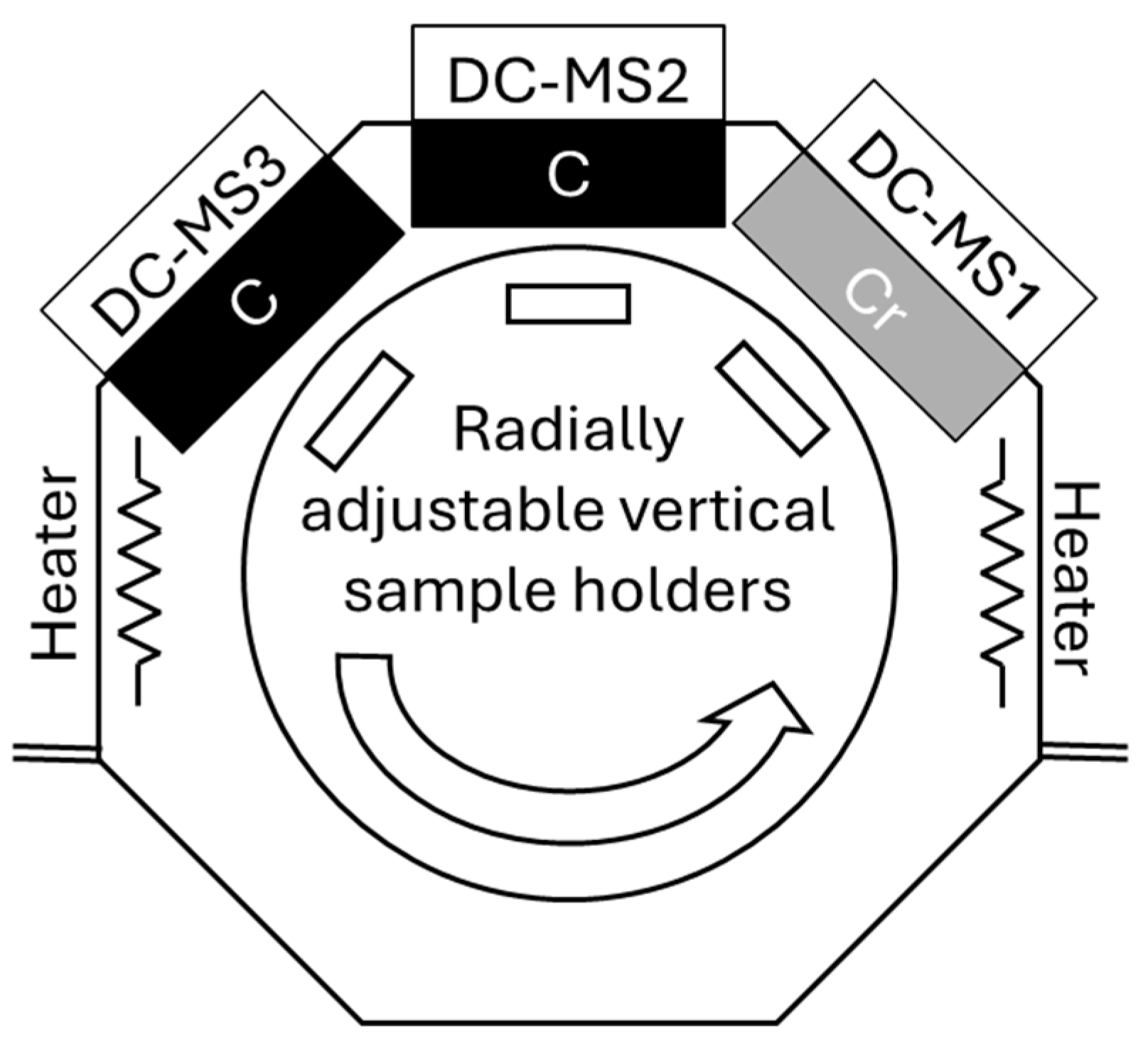
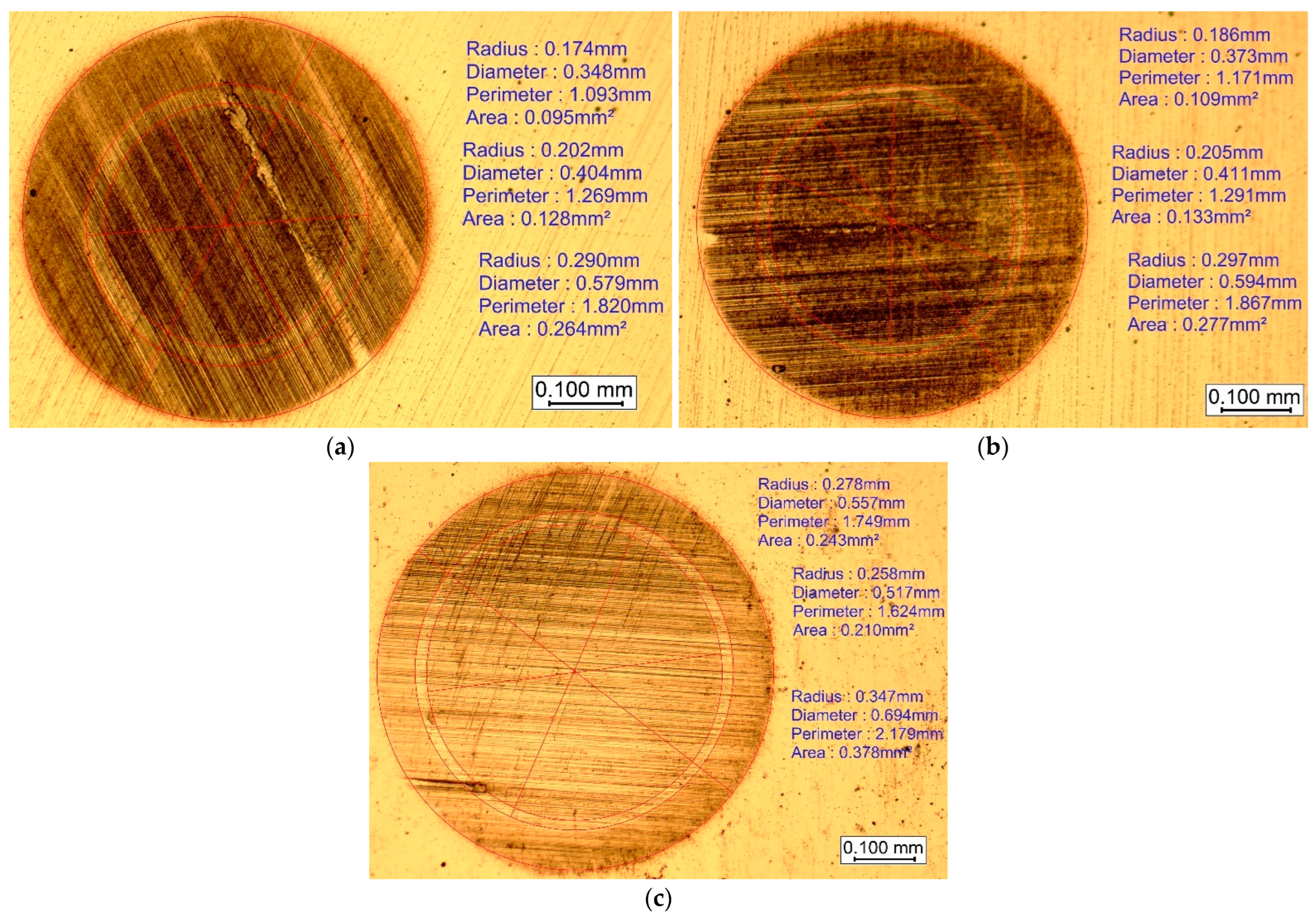
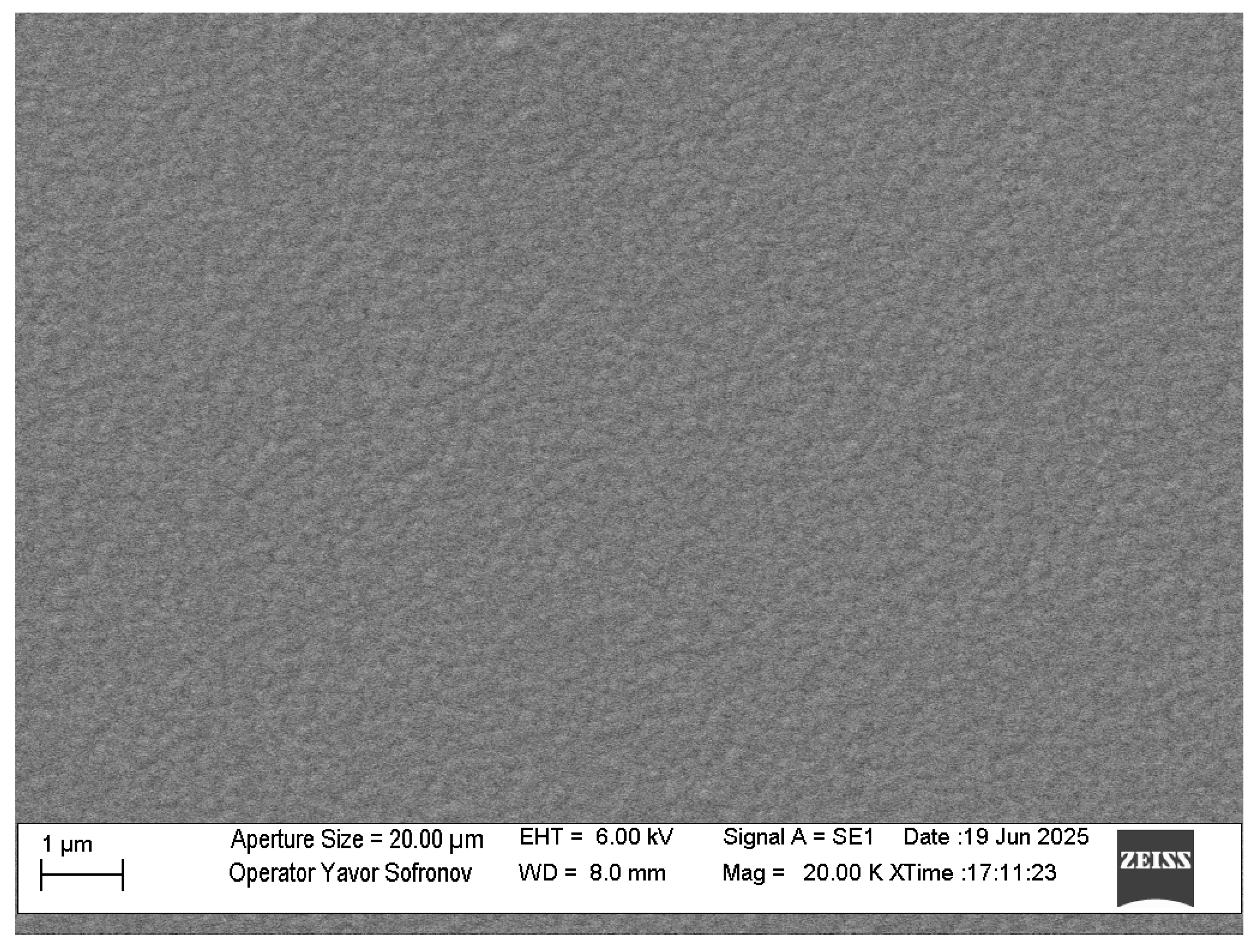

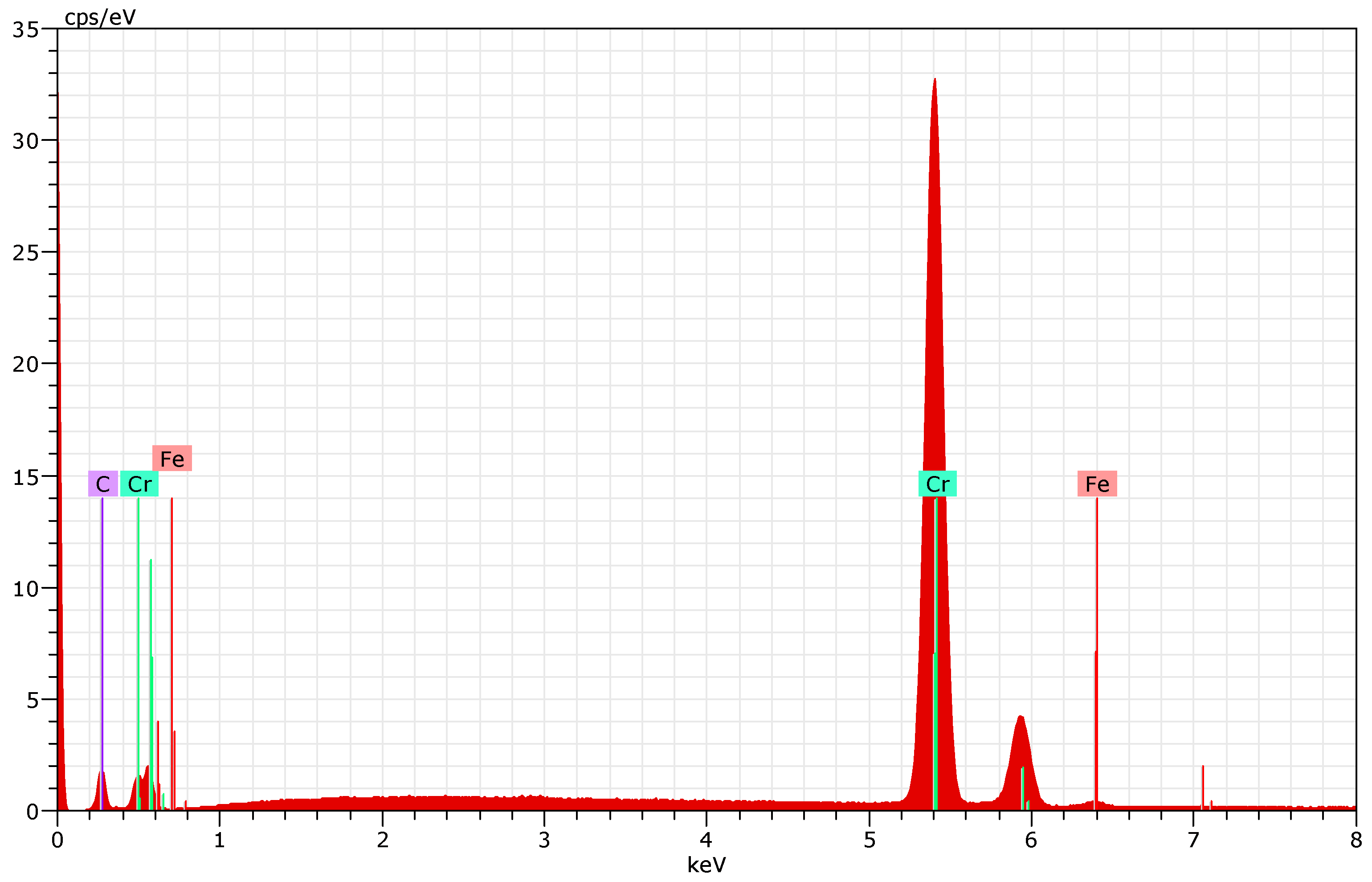

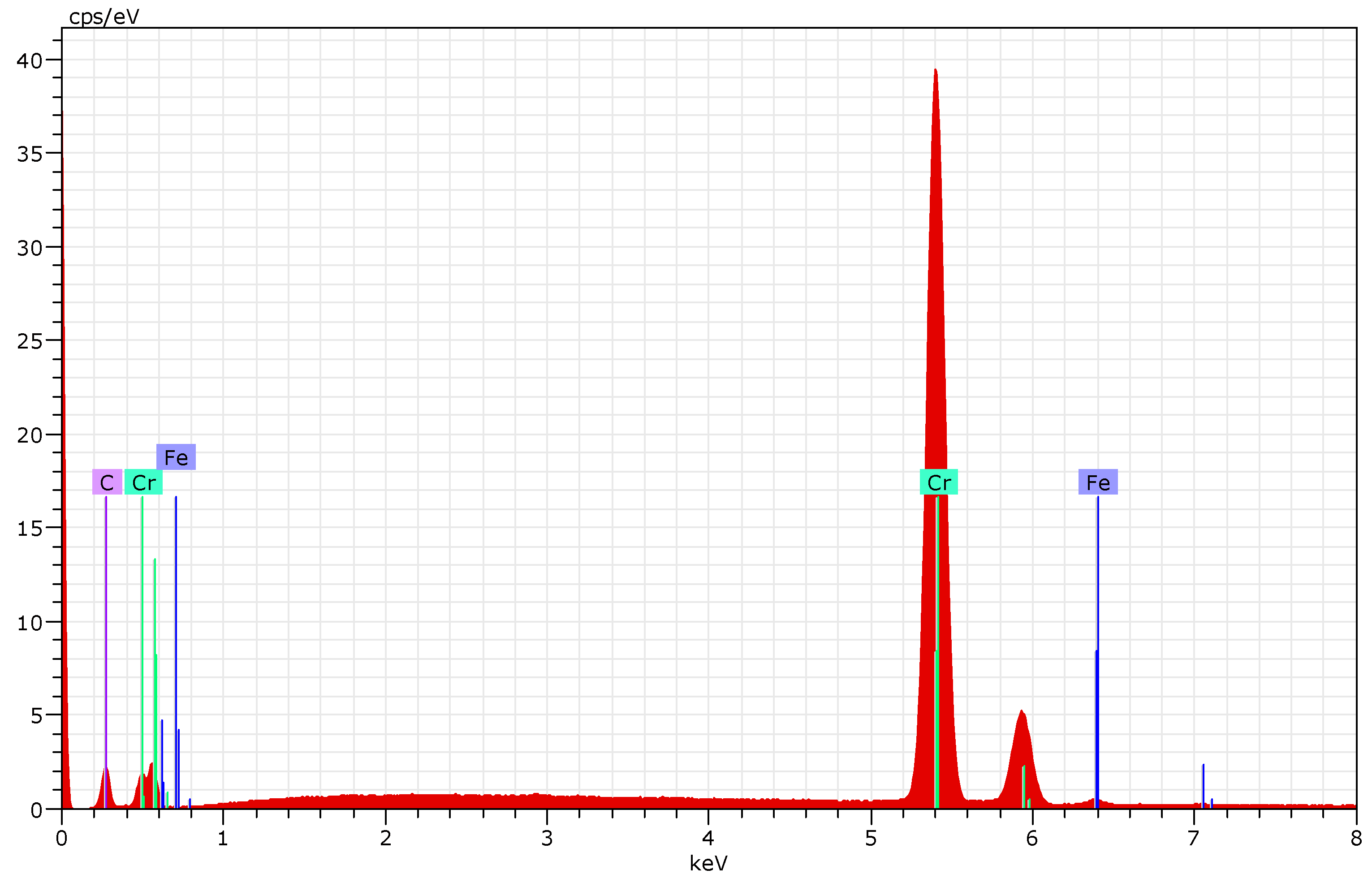
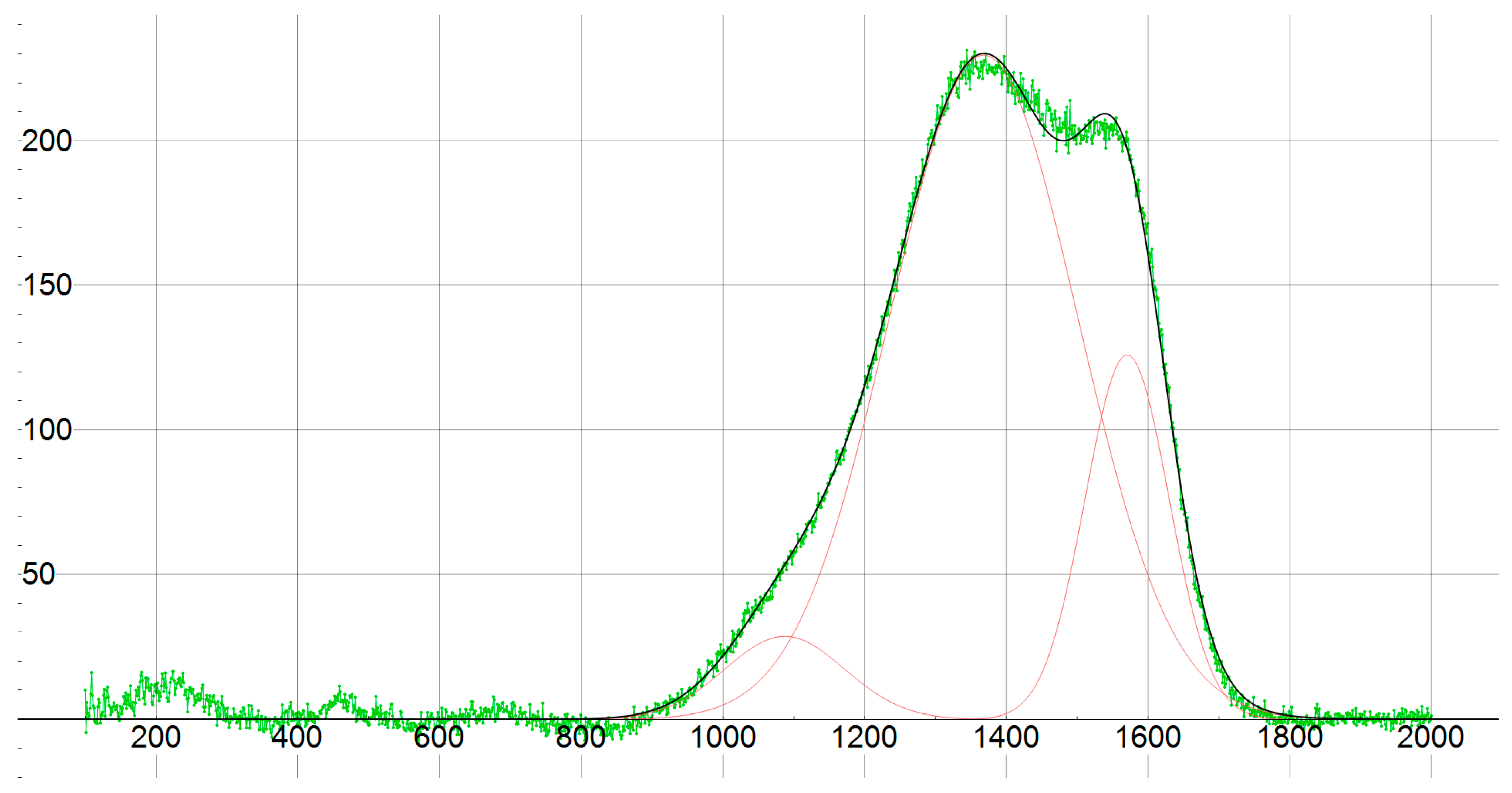
| Substrate Material | Sublayer | (Cr/a-C)ml Coating | PVD Coating Total Thickness | PVD Coating Average Thickness |
|---|---|---|---|---|
| 42CrMo4 | 0.264 µm 0.351 µm 0.328 µm | 1.571 µm 1.434 µm 1.539 µm | 1.835 µm 1.784 µm 1.868 µm | 1.829 ± 0.03 µm |
| 100Cr6 | 0.143 µm 0.248 µm 0.278 µm | 1.611 µm 1.533 µm 1.461 µm | 1.754 µm 1.781 µm 1.738 µm | 1.758 ± 0.016 µm |
| HS18-0-1 | 0.299 µm 0.358 µm 0.422 µm | 1.462 µm 1.428 µm 1.301 µm | 1.761 µm 1.786 µm 1.722 µm | 1.756 ± 0.023 µm |
| Element | Atomic % | Atomic % | Atomic % | Atomic % Average |
|---|---|---|---|---|
| Cr | 69.33 | 69.73 | 69.52 | 69.53 |
| C | 29.96 | 29.61 | 29.80 | 29.79 |
| Fe | 0.71 | 0.65 | 0.68 | 0.68 |
| Center | Intensity |
|---|---|
| 1368 | 229.597 |
| 1571 | 125.859 |
| Sp3/Sp2 (Int) = 1.82 | |
| SEQ | Fmax [mN] | hmax [µm] | hp [µm] | hr [µm] | HMT115 [N/mm2] | HMs [N/mm2] | Hit [N/mm2] | Eit [N/mm2] | Cit [%] | nit [%] | HV+ | Rer [%] |
|---|---|---|---|---|---|---|---|---|---|---|---|---|
| 1 | 5.08 | 0.1033 | 0.0633 | 0.0804 | 1803.787 | 11,561.121 | 28,616.229 | 685,300 | 2.122 | 33.21 | 2644.139 | 38.803 |
| 2 | 5.08 | 0.1093 | 0.061 | 0.0765 | 1610.883 | 12,162.525 | 29,555.637 | 422,400 | 3.491 | 44.752 | 2730.941 | 42.925 |
| 3 | 5.09 | 0.1093 | 0.0523 | 0.0674 | 19,126.373 | 15,543.851 | 37,142.172 | 483,900 | 1.314 | 50.055 | 3431.937 | 46.855 |
| 4 | 5.08 | 0.1058 | 0.0541 | 0.0714 | 17,188.176 | 13,111.882 | 33,171.613 | 437,100 | 2.306 | 47.967 | 3065.057 | 48.104 |
| 5 | 5.08 | 0.1078 | 0.0511 | 0.0656 | 18,544.305 | 16,019.188 | 38,055.906 | 434,000 | 1.088 | 51.413 | 3516.366 | 48.822 |
| 6 | 5.08 | 0.097 | 0.0501 | 0.0661 | 20,427.801 | 12,314.193 | 38,885.379 | 558,600 | 0.951 | 47.408 | 3593.009 | 47.002 |
| 7 | 5.08 | 0.1096 | 0.0621 | 0.0731 | 16,012.796 | 15,338.083 | 31,361.984 | 378,000 | 1.997 | 44.161 | 2897.847 | 41.583 |
| 8 | 5.09 | 0.1074 | 0.0584 | 0.0764 | 16,691.564 | 14,679.676 | 29,989.211 | 458,800 | 1.549 | 45.573 | 2771.003 | 44.107 |
| 9 | 5.09 | 0.1043 | 0.0553 | 0.0707 | 17,888.674 | 10,897.512 | 33,946.418 | 443,800 | 1.929 | 46.987 | 3136.649 | 46.446 |
| 10 | 5.09 | 0.1056 | 0.0594 | 0.0736 | 17,525.846 | 12,629.287 | 31,898.174 | 458,400 | 2.343 | 43.574 | 2947.391 | 41.902 |
| Average | 5.08 | 0.1044 | 0.0567 | 0.0721 | 17,700.49 | 13,065.732 | 33,262.273 | 476,000 | 1.863 | 45.51 | 3073.434 | 44.755 |
| Std Dev | 0.001 | 0.004 | 0.005 | 0.005 | 1387.461 | 1761.189 | 3676.32 | 86,974.93 | 0.746 | 4.997 | 339.692 | 3.101 |
| CV | 0.024 | 3.804 | 8.405 | 6.739 | 7.802 | 13.49 | 11.053 | 18.271 | 9.128 | 10.981 | 11.053 | 6.93 |
Disclaimer/Publisher’s Note: The statements, opinions and data contained in all publications are solely those of the individual author(s) and contributor(s) and not of MDPI and/or the editor(s). MDPI and/or the editor(s) disclaim responsibility for any injury to people or property resulting from any ideas, methods, instructions or products referred to in the content. |
© 2025 by the authors. Licensee MDPI, Basel, Switzerland. This article is an open access article distributed under the terms and conditions of the Creative Commons Attribution (CC BY) license (https://creativecommons.org/licenses/by/4.0/).
Share and Cite
Dochev, B.; Sofronov, Y.; Mishev, V.; Nikolov, A.; Petrov, K.; Angelov, M.; Yordanov, M.; Todorov, G.; Marchev, K. Deposition of Multilayer Nanostructured Coating Cr/(Cr/a-C)ml on Alloy Steels. Materials 2025, 18, 4923. https://doi.org/10.3390/ma18214923
Dochev B, Sofronov Y, Mishev V, Nikolov A, Petrov K, Angelov M, Yordanov M, Todorov G, Marchev K. Deposition of Multilayer Nanostructured Coating Cr/(Cr/a-C)ml on Alloy Steels. Materials. 2025; 18(21):4923. https://doi.org/10.3390/ma18214923
Chicago/Turabian StyleDochev, Boyan, Yavor Sofronov, Valentin Mishev, Antonio Nikolov, Krum Petrov, Milko Angelov, Milko Yordanov, Georgi Todorov, and Krassimir Marchev. 2025. "Deposition of Multilayer Nanostructured Coating Cr/(Cr/a-C)ml on Alloy Steels" Materials 18, no. 21: 4923. https://doi.org/10.3390/ma18214923
APA StyleDochev, B., Sofronov, Y., Mishev, V., Nikolov, A., Petrov, K., Angelov, M., Yordanov, M., Todorov, G., & Marchev, K. (2025). Deposition of Multilayer Nanostructured Coating Cr/(Cr/a-C)ml on Alloy Steels. Materials, 18(21), 4923. https://doi.org/10.3390/ma18214923








